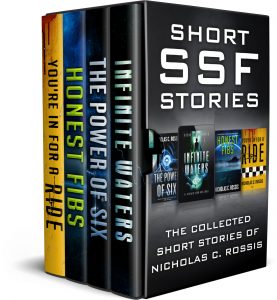 As you may know, short stories are how I started writing and I still love them dearly. The short story, however, is not a single literary format but multiple ones grouped under a single banner. This gives short story writers a multitude of structures to use to tell the stories they wish to tell in the most compelling, engaging, and effective manner possible.
As you may know, short stories are how I started writing and I still love them dearly. The short story, however, is not a single literary format but multiple ones grouped under a single banner. This gives short story writers a multitude of structures to use to tell the stories they wish to tell in the most compelling, engaging, and effective manner possible.
Here are 10 of the most common short story forms to take a stab at with your proverbial–or literal–quill. As you will see, some of these are defined by their size, either in word or sentence count; others, by their style or form.
1. The One-Sentence Story
“The last man on Earth heard a knock on the door.”
There are a surprising number of one-sentence novels, so a one-sentence short story shouldn’t be so difficult by comparison. A story has a beginning, middle, and end, and so does a sentence. The trick is to make those three elements tell a cogent story before that singular period.
2. The Six-Sentence Story
Tell a story in just six sentences–not five, not seven. It doesn’t matter how many words each sentence contains, as long as it makes sense (and even then, you could still go all “Finnegan’s Wake” on it. If you want to be overly formalistic about it, you could say that gives you two sentences for the beginning, two for the middle, and two for the end. But why be so formal?
3. Flash Fiction
This is any story written in 1,000 words or less. That makes it an ideal form for stories focused on flashes of insight or activity. The goal of a flash fiction piece is usually to leave a strong impact in a veritable instant of time.
4. Micro Fiction
This is a subcategory of flash fiction for stories that generally comprise 400 words or less. These usually focus on a single moment, detail, thought or observation.
5. The Drabble
Started by Birmingham University’s Science Fiction Society in the 1980s, this form strives to tell a story in under 100 words. The name is borrowed from “Drabble. A word game for 2 to 4 players” – a joke in Monty Python’s “Big Red Book”. Originally a science fiction writing contest, the form gained popularity over the internet, and writers in all genres now experiment with it.
6. The Prose Poem
The prose poem takes two distinct forms and blends them into one. It is essentially a poem written in prose… or, wait, it’s a prose piece written as a poem. Maybe it’s neither, or possibly both. However you perceive it–and every prose writer and poetry writer seems to see it differently–the consensus seems to be that it helps improve your writing.
7. The Cadralor
A variation on a prose poem, a cadralor is made up of five stanzas, each numbered, each unrelated; the fifth stanza answers a specific question, namely: “For what do you yearn?” Think of it like five different and distinct photographs that, strung together, tell a single narrative. This narrative is often more conceptual and thematic or tonal than it is literal.
8. The Hermit Crab
Like the animal after which it’s named, this story occupies the shell of another story as its own. It takes any formula and follows it like a recipe to produce something ideally new yet familiar. For example, Pulitzer Prize-winning author Jennifer Egan wrote a Twitter story composed of individual tweets.
9. The Listicle
This could be said to be one type of hermit crab story, told in the form of a list of items, elements, or segments.
10. The Novelette
In contrast to all these shorter forms of short storytelling, here’s a longer one or, from the opposite angle, a shorter novel. Not even as long as a novella, which is technically a short novel, this form is defined less by specific sentence count or word count and more by merely existing in the nebulous space between short story and novella.
Conclusion
The variety of short story forms is vast. It should come as no surprise that so many movies are adapted from them. If you want to see how different types of short stories can develop into full-length feature films, check out “The Curious Case of Benjamin Button” (on DIRECTV STREAM) based on a short story by F. Scott Fitzgerald, “Minority Report,” which was in turn based on the short story “The Minority Report” by Philip K. Dick. Also check out “All About Eve” (on fuboTV) based on the short story “The Wisdom of Eve” by Mary Orr.





WOW–a whole bunch of things I’ve never heard of! Will have to bookmark this for future use when current projects and obstacles are done.
So glad you enjoyed it, John! Thank you 🙂
As educational as ever. I dabble in drabbles but didn’t realise I was nor that I linked to Python…
We all like to think we have a unique style, but there’s nothing new under the sun, I guess!